List Of Over 30 Fantastic Garden Flowers For Bees!
Here are over 30 fantastic garden flowers for bees (it was originally 30 - but I keep adding flowers to it!).
Please note: there is a separate page for bulbs and corms (including muscari, alliums etc).
Popular herbs, such as Oregano, Anise hyssop, Monarda (Bee balm) and Lavender are found on a separate page, herb planting for bees.
Fantastic Garden Flowers For Bees
Here's the list:
Amberboa moschata - Sweet sultan
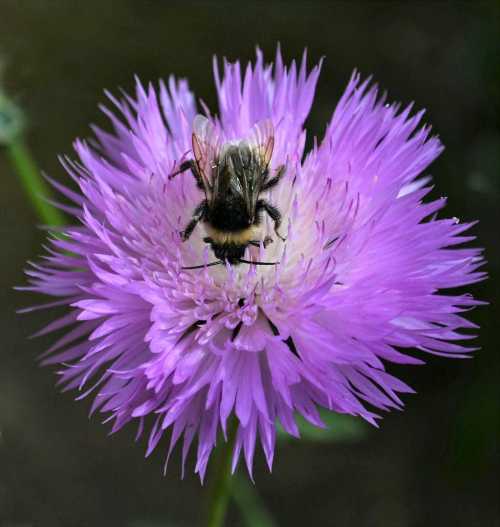 Sweet sultan is attractive to bees.
Sweet sultan is attractive to bees.Often overlooked and forgotten, this lovely cottage garden annual has beautiful, scented flowers. It is also long flowering, and easy to grow from seeds sown April to May. Bees love it!
Centaurea montana - Cornflower
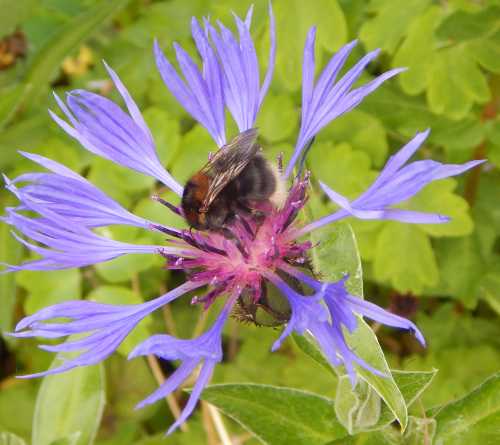
I have the perennial Mountain cornflower - Centuarea montana, and love the silvery leaves and bees love the
flowers!
Read more about growing cornflowers for bees, including scientific data on nectar and pollen provision.
Cirsium rivulare - 'Atropurpureum' - Plume thistle
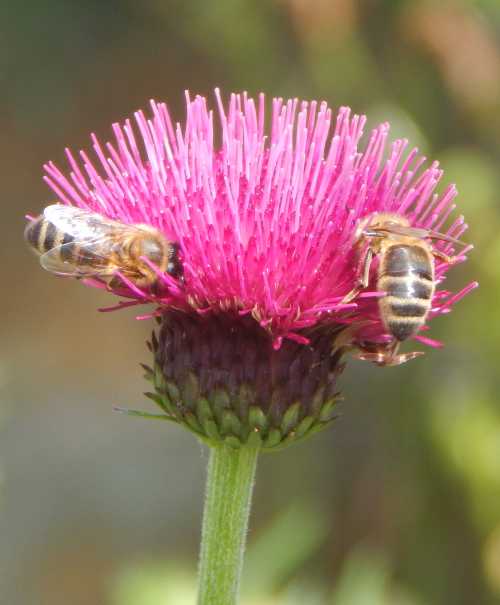
Just like its wild thistle cousins, the plume thistle Cirsium rivulare - 'Atropurpureum' provides lots of nectar for bees during the summer, and is very attractive for honey bees, bumble bees, solitary species and butterflies.
Cosmos bipinnatus - Cosmos
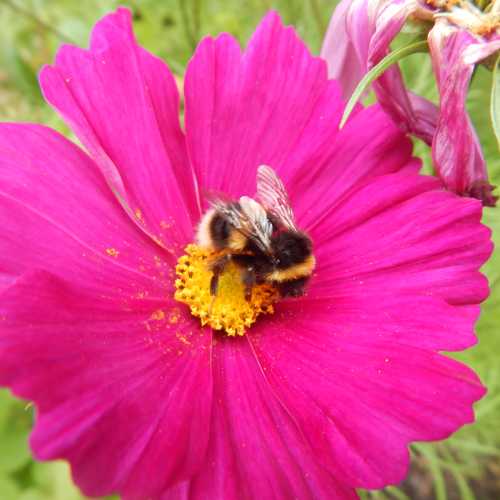 Bees can't resist the beautiful cosmos flower.
Bees can't resist the beautiful cosmos flower.
Gorgeous, tall annual flowers on wonderful stems with feathery leaves.
An absolute favourite with bees, providing plenty of nectar and pollen!
Sow them in seed trays in compost during Feb – March under cover, and transplant them into the flower border when danger of frost has passed, or sow them directly into the ground where they are to flower. Read about Cosmos bipinnatus.
Leucanthemum vulgare - Oxeye daisy
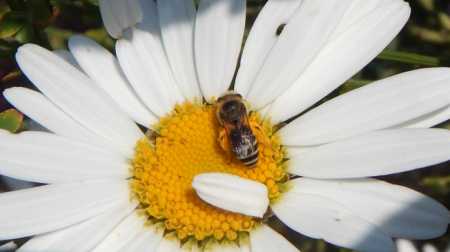 Davies Colletes -
Colletes daviesanus foraging on a oxeye daisy
Davies Colletes -
Colletes daviesanus foraging on a oxeye daisyDaisies of various types provide pollen for a range of bees, such as Davies’ colletes – (Colletes daviesanus) pictured above. These cheerful flowers are easy to grow.
Read more about dazzling daisies and bees.
Digitalis purpurea – Foxglove
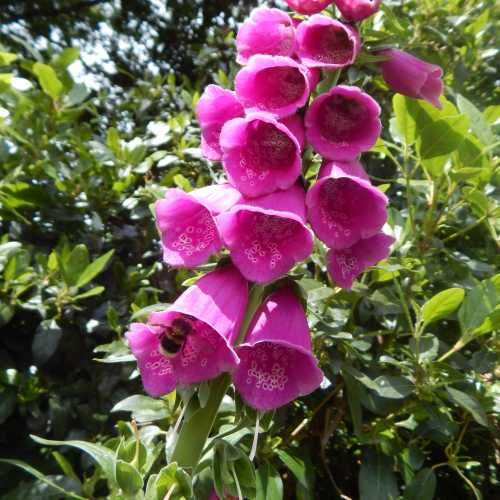 Bumble bees are especially keen to visit foxgloves.
Bumble bees are especially keen to visit foxgloves.
Watch with delight as bumble bees crawl inside the gullet-type blossoms! In my experience, these are happy in partial
shade, where they are still visited by bumble bees – and then help brighten up a
shady corner.
I have the biennial foxgloves, but apparently it is possible to get them as a short-lived perennial. I can’t say this is the best or most efficient way to plant foxglove, but I simply threw the seeds into an informal part of my garden, and was fortunate that some plants came up!
Echinacea - Coneflower
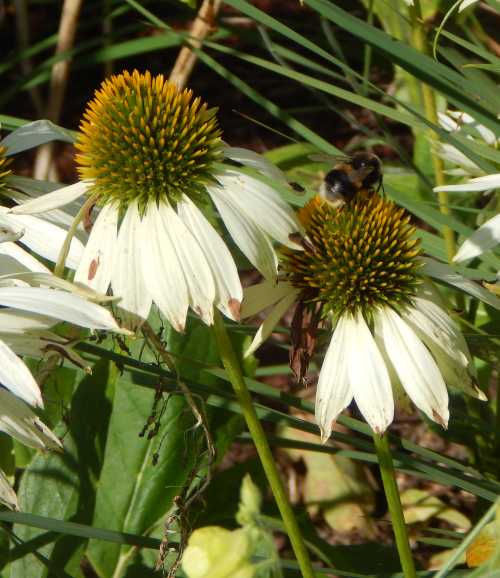 Echinacea - a must have for pollinator gardens.
Echinacea - a must have for pollinator gardens.
Echinacea has tall, sturdy stems and vibrant daisy-like blooms are a joy to look at, and are loved by bees and butterflies.
Erigeron glaucus – Beach Aster
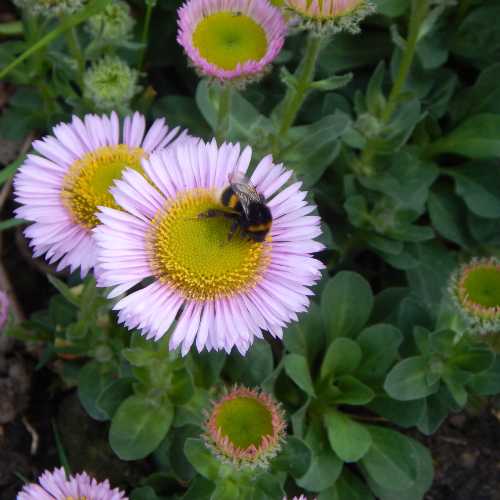 Beach aster is perfect for dry spots, and attracts all kinds of bees.
Beach aster is perfect for dry spots, and attracts all kinds of bees.Flowers from late May or June onwards, and long
flowering. Fantastic, low growing
evergreen perennial, perfect for those dry spots in the garden, and sandy
soils. Provides excellent ground cover.
Once in full bloom, one day you’ll notice many bees foraging on the open flowers. Bumble bees are especially keen, but the flowers will also attract honey bees and solitary bees. Will tolerate a little shade, but prefers full sunshine to attract plenty of bees.
As an aside, Erigeron glaucus is related to Erigeron annus, which according to a study, provides pollen which contains all 10 essential protein amino acids for bees
Erysimum - Wallflower
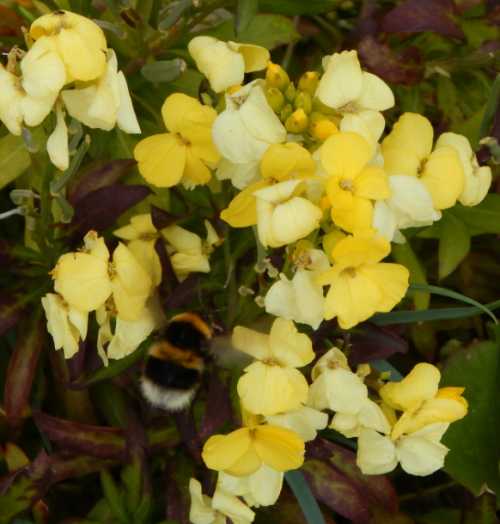 Fragrant wallflowers will attract bumble bees.
Fragrant wallflowers will attract bumble bees.A cottage garden favourite! Look for the traditional, scented varieties. Bees and butterflies love them! Wallflowers are tolerant of poor soils too - or even little soil! Give them full sun, although they will tolerate some light shade.
Eryngium – Sea holly
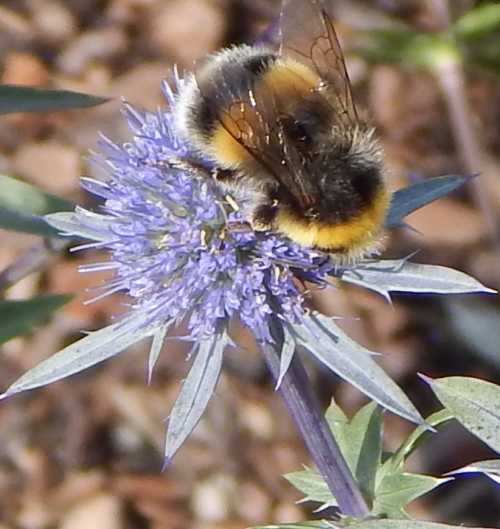 Beautiful jewel blue sea holly flowers are a magnet for all kinds of bees and butterflies.
Beautiful jewel blue sea holly flowers are a magnet for all kinds of bees and butterflies.This plant grows wild in the local landscape where I live, and I know people who do indeed grow it in their gardens - and bees love it. It may be one I'll add to my garden in the future. It can grow in well drained soil, and it's great for sandy soil and dry conditions – if you
live in a coastal area, this could be perfect for your garden.
Plant it in full sun, and watch the bees land on it from June onwards. Read more about Eryngium and bees.
Glebionis segetum - Corn marigold
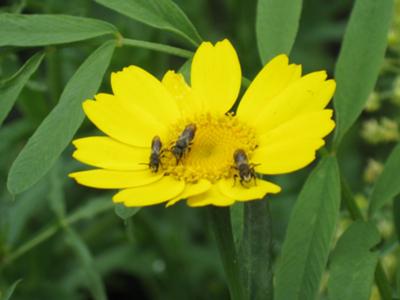 Heriades truncorum (large-headed resin bees) on corn marigold. (Image submitted by Marco, Netherlands)
Heriades truncorum (large-headed resin bees) on corn marigold. (Image submitted by Marco, Netherlands)Offering lots of nectar and a reasonable amount of pollen, corn marigolds are cheerful flowering plants, visited by a variety of bees, including Heriades truncorum (large-headed resin bee).
Pot marigold, Calendula officinalis, are useful for pollinators, and both have been scientifically assessed in their provision of food for pollinators. See Do Bees Like Marigolds?
Geranium - Hardy geranium / Cranesbill
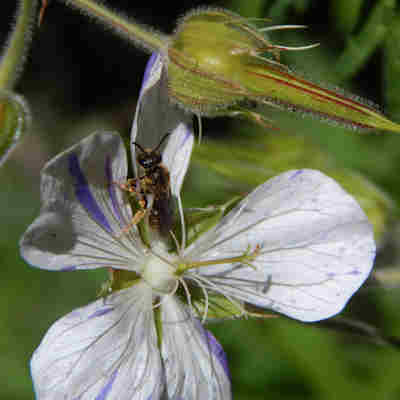 Hardy geraniums attract many species of bees, and are easy to grow.
Hardy geraniums attract many species of bees, and are easy to grow.A fab herbaceous perennial visited by many bee species. Lovely open
flowers from May onwards. Different varieties will help you extend the
season. I have a purple geranium (a variety I think is called 'Brookside'), which blooms first (end May/beginning June onwards), and this one above, which blooms about 2 weeks later. Read more about Geraniums for bees.
Helenium - Sneezeweed
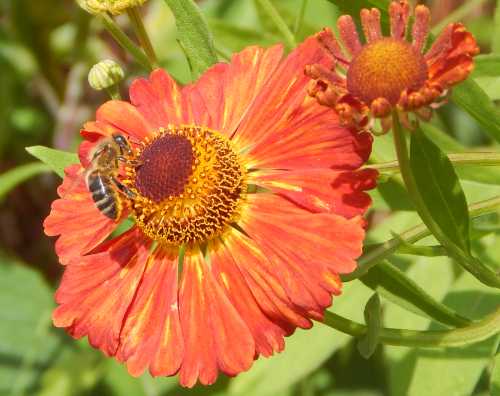 Gorgeous blooms to brighten up the flower border, sneezeweed feeds bees from summer through autumn.
Gorgeous blooms to brighten up the flower border, sneezeweed feeds bees from summer through autumn.Helenium - sneezeweed is a lovely tall perennial attractive to honey bees, bumble bees and solitary species. Give them full sun.
Gorgeous in the border.
Helichrysum bracteatum – Straw flowers
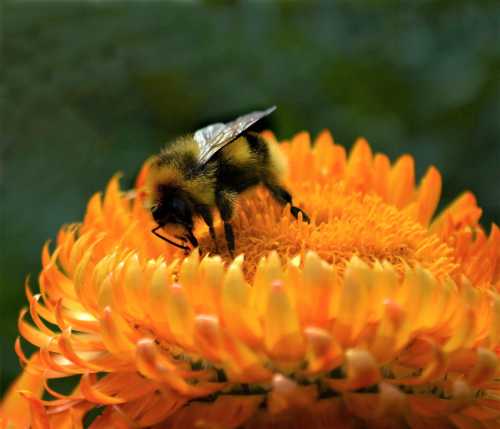 Bumble bee foraging on straw flower.
Bumble bee foraging on straw flower.Pollinators are attracted to this pretty flower. Lots of lovely, bright shades of oranges and pinks available, and the flower itself is good for drying, and can be used in dried floral arrangements.
Linarea purpurea - Purple Toadflax
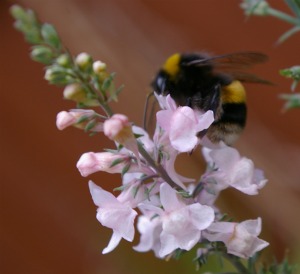 Purple toadflax is easy to grow from seed and bumble bees love it.
Purple toadflax is easy to grow from seed and bumble bees love it.Flowers from late May or June onwards, and long, long flowering - especially if you cut the stems just before each of the little flowers has gone to seed (wait until there are just a couple of little flowers left at the top of the stem). They will then throw up more stems of flowers, hence extending the foraging opportunity for bees. A lovely, tall flower with spikes of pale
pink or purple flowers.
Self seeds easily (plants can easily be transplanted or simply pulled out and given to friends if you don’t want them. They may wilt for a while when transplanted, but water well, and they'll recover by showing new growth).
Lupinus - Lupin / Lupine
 Include lupins (or lupines) in your garden - bumble bees love them.
Include lupins (or lupines) in your garden - bumble bees love them.Fantastic herbaceous perennial and cottage garden favourite. Bumble bees in particular, love the flag
blossoms. Protect them from slugs using
a soil garlic drench, not slug pellets. Read more about lupins.
Papaver - Poppy species
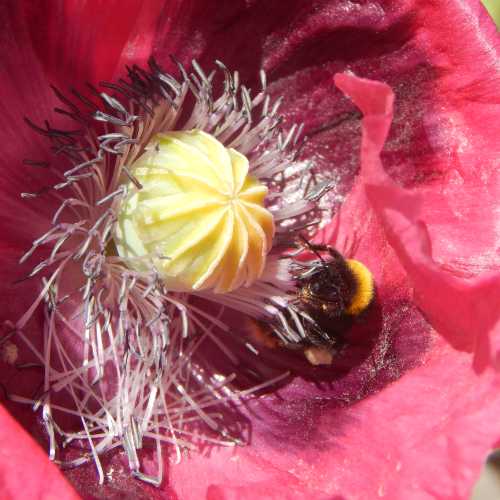 It's wonderful to watch bumble bees inside the head of a poppy flower, buzzing away busily as it gathers the pollen.
It's wonderful to watch bumble bees inside the head of a poppy flower, buzzing away busily as it gathers the pollen.
I especially like the Papaver
somniferum for bees. Beed love their pollen-laden anthers. Bumble bees can be
heard vibrating their bodies against the anthers to release the pollen. Poppies need a sunny spot and will flower
from May/June onwards.
Phacelia tanacetifolia - Scorpion weed
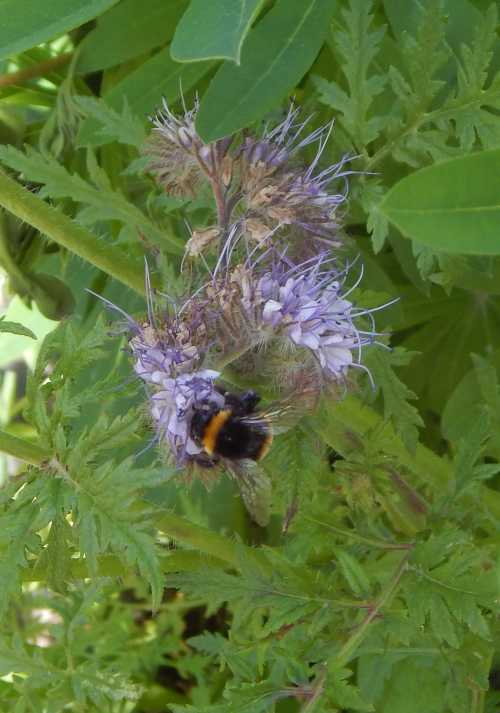 Scorpion weed is one of the easiest flower to grow for bees.
Scorpion weed is one of the easiest flower to grow for bees.
Well known as a bee magnet, and very easy to grow from seed. Sprinkle Phacelia seeds thinly on a prepared
seed bed where they are to flower. You’ll
be rewarded with lovely blue flowers for bees, and the happy buzzing sound of
furry pollinators!
Pulmonaria - Lungwort
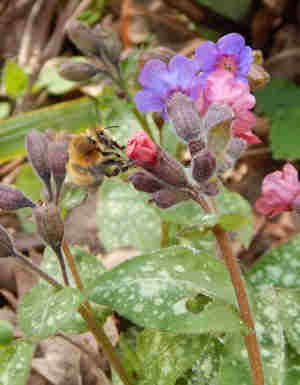 Hairy footed flower bees love lungwort - an important food source for bees early in spring.
Hairy footed flower bees love lungwort - an important food source for bees early in spring.
A must have for bees, providing early food when little else is available. Pulmonaria produces flowers anywhere between January and May,
depending on your location.
Bumble bees and hairy footed flower bee, will be very grateful if you include this evergreen perennial in your garden.
Salvias - Sages
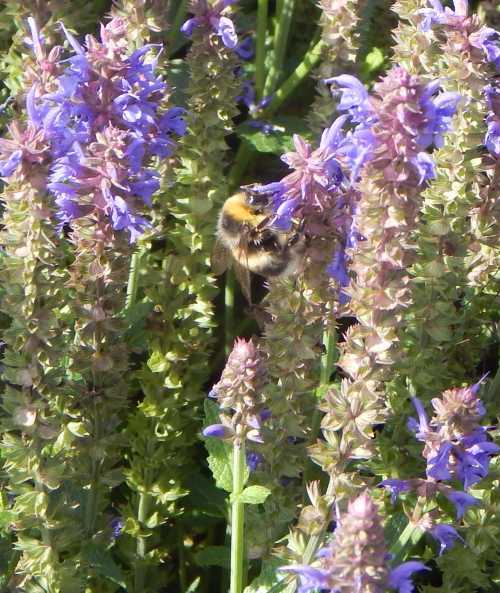 Bumble bee on Salvia
Bumble bee on SalviaPart of the sage and mint family of plants. Many ornamental varieties are popular with bees.
Scabiousa – Pin cushion flower
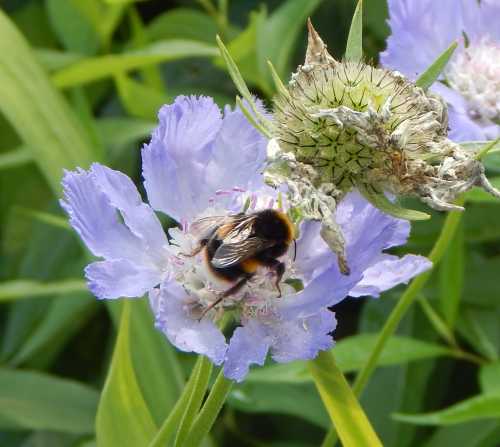 Plant pin cushion flower to encourage a visit from bees and butterflies.
Plant pin cushion flower to encourage a visit from bees and butterflies.
A magnet for bees and butterflies. Grow it in full sun.
Sedum Spectabile - Ice plant
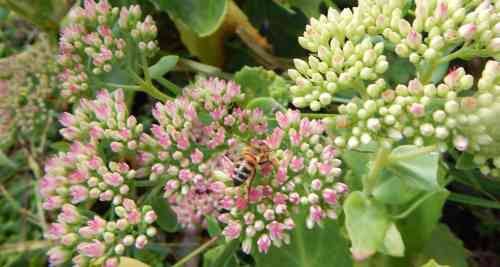 Honey bee on sedum.
Honey bee on sedum.
Provides lots of nectar for honey bees, bumble bees and solitary bees from late
summer onwards.
Sedum spectabile - ice plant is an easy to grow succulent. Sunshine is best, although I have a patch which is in light shade at least for some of the day. Great for dry soil locations.
Sidalcea - Mallows
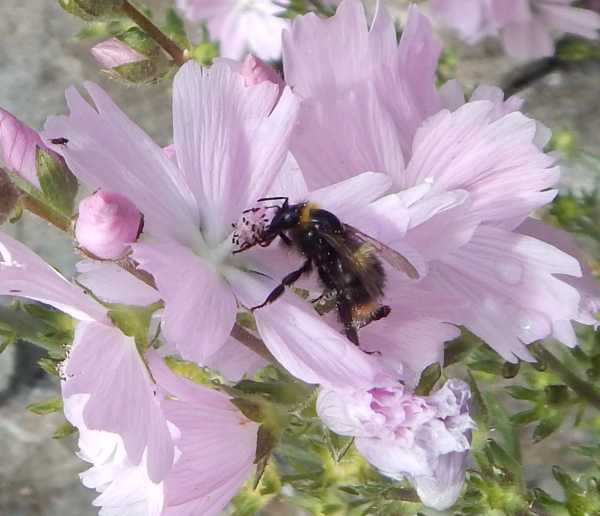 Mallows are great for bees of many species.
Mallows are great for bees of many species.Mallows are great for bees of many species, and they look lovely in the border. Pictured above is Prairie Mallow, Sidalcea ‘Elsie Heugh’. This lovely plant has long stems of flowers that are sturdy, and don't need staking.
Solidago – Goldenrods
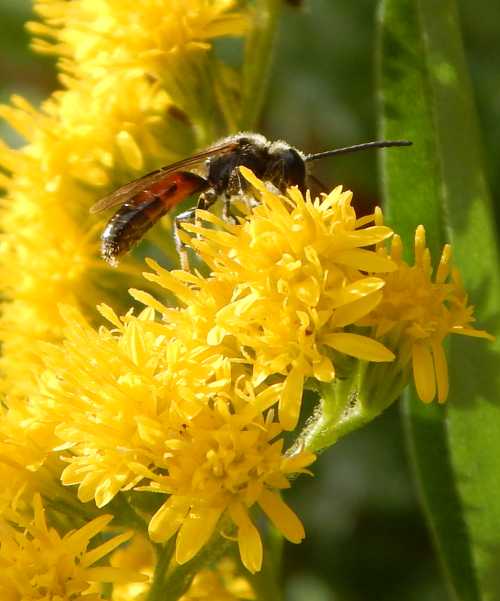 Solidago will attract honey bees, bumble bees and solitary bees of various species, such as this bloomed furrow bee.
Solidago will attract honey bees, bumble bees and solitary bees of various species, such as this bloomed furrow bee.
Solidago is a fantastic flowering plant for a variety of bees, hover flies and sweet little
beetles! Yellow flowers from summer through to early
autumn.
Stachys byzantina - Lamb’s Ear
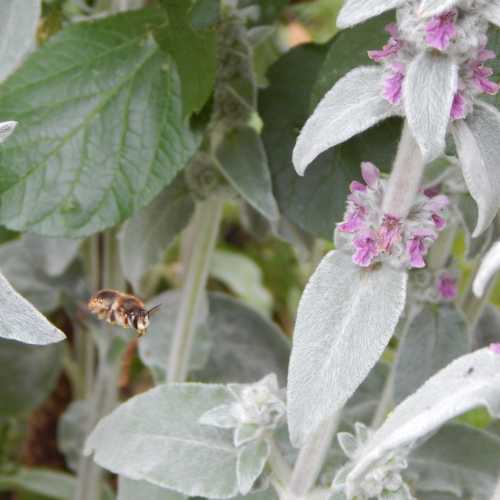 Wool carder bees forage on lamb's ear flowers, and collect the plant hairs for their nests.
Wool carder bees forage on lamb's ear flowers, and collect the plant hairs for their nests.Providing nectar from delicate pinkish flowers on spikey stems, the flowers are especially helpful for wool carder bees, and if you are lucky, you will observe them collecting some of the hairs from the leaves for the building of their nests. Also popular with bumble bees and other solitary bees. Flowers from late May/June onwards, and long flowering. Go for the perennial variety and plant it in full sun.
Helianthus - Sunflower
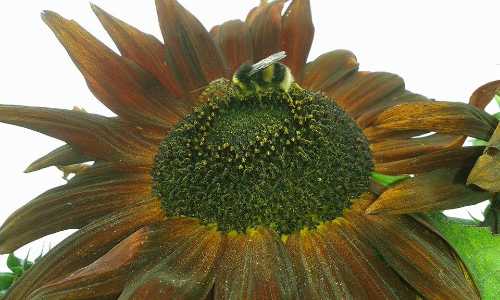 Bees love sunflowers.
Bees love sunflowers.
Who can resist sunflowers? Well the bees
can’t! So many varieties to choose
from, and not merely the very large headed varieties!
Tropaeolum - Nasturtium
So easy to grow, this plant rambles along the ground nicely, producing an abundance of flowers ranging from sunshine yellow and orange to deep rusts and reds. I recommend the traditional, orange and orangey-red colours.
Long tongued bumble bees, such as Bombus hortorum, are especially partial to the nasturtium flower! The flowers are also edible for humans, of course, and each plant pops out so many flowers, I’m sure the bees won’t mind if you snaffle a few! They spread rapidly, or you can train them to climb. Just give them plenty of space.
Verbena bonariensis - Purple top vervain
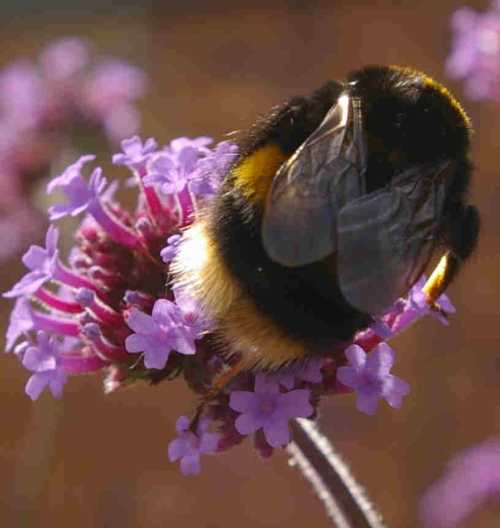 Purple top vervain - a favourite for bees and butterflies.
Purple top vervain - a favourite for bees and butterflies.One of my favourites, as it adds both height and softness to a border, with its slender stems and flowers at the top.
I
recommend this perennial, and if bees could cast votes, I reckon they would vote for this one too! Flowers from
summer through to autumn.
Zinnia - Zinnia
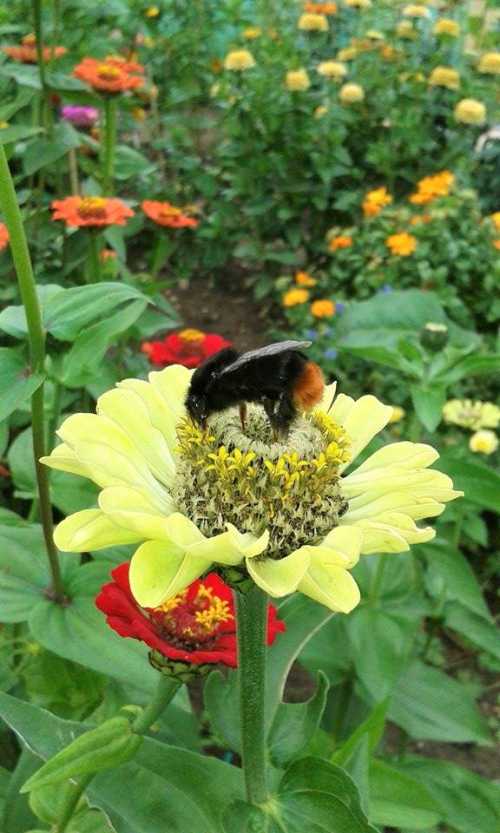 You need the right conditions to grow Zinnia, but if you can grow them you'll be rewarded with vibrant blooms, and hopefully lots of bees and butterflies.
You need the right conditions to grow Zinnia, but if you can grow them you'll be rewarded with vibrant blooms, and hopefully lots of bees and butterflies.Zinnias are loved by bees and other pollinators too. Stunning, with an
abundance of colours, from deep jewelled pinks and reds to amazing
acid green and rusty orange. Irresistible!
Reference
1. Ghosh, S., Jeon, H. & Jung, C. Foraging behaviour and preference of pollen sources by honey bee (Apis mellifera) relative to protein contents. j ecology environ 44, 4 (2020). https://doi.org/10.1186/s41610-020-0149-9
If you found this page helpful or interesting, I'd really be grateful if you would share it with others - if not this page, perhaps another, such as Gardening For Bees.
Thank you so much :) .